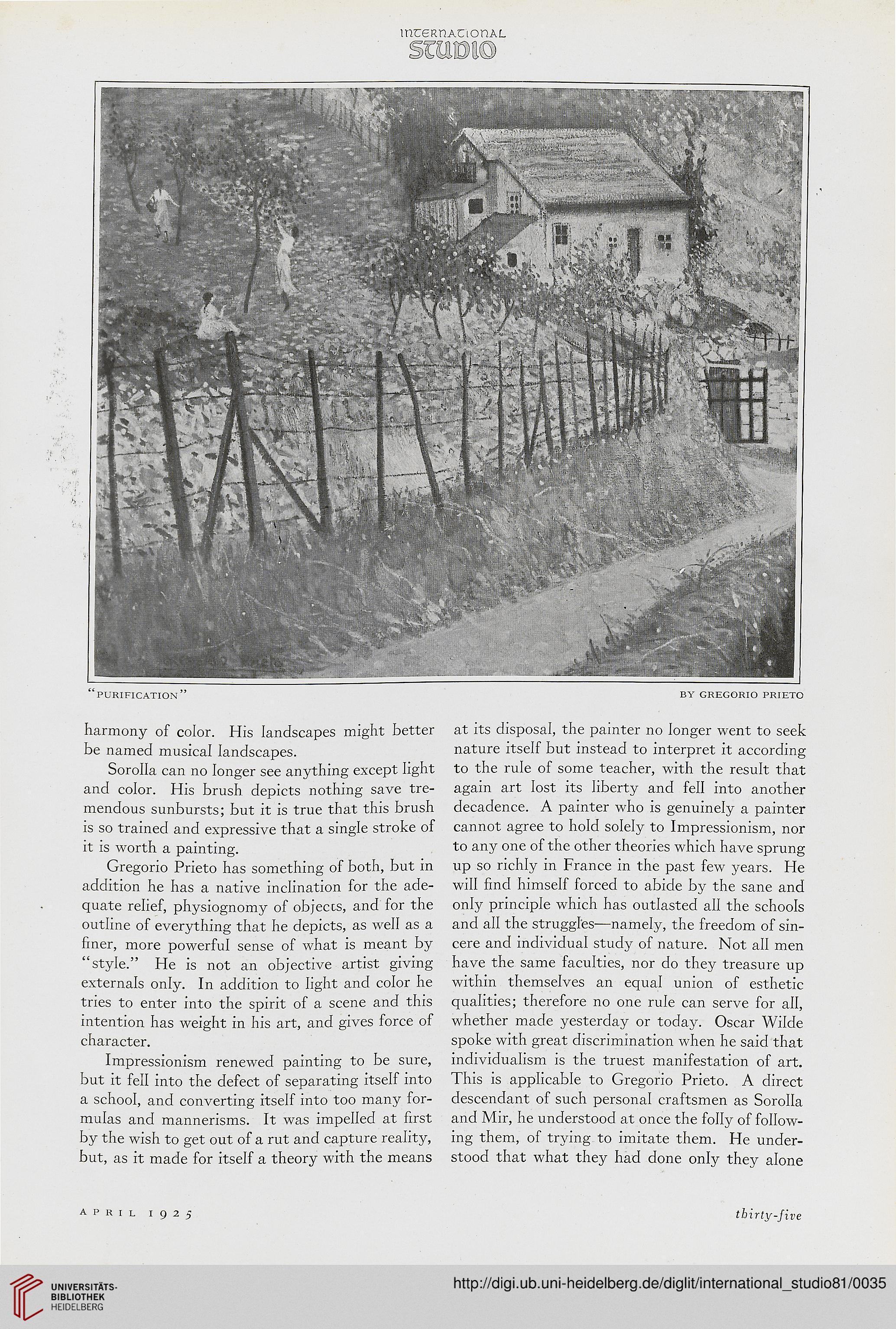UXCSRTlAC'lOnAL
purification by grecorio prieto
harmony of color. His landscapes might better at its disposal, the painter no longer went to seek
be named musical landscapes. nature itself but instead to interpret it according
SoroIIa can no longer see anything except light to the rule of some teacher, with the result that
and color. His brush depicts nothing save tre- again art lost its liberty and fell into another
mendous sunbursts; but it is true that this brush decadence. A painter who is genuinely a painter
is so trained and expressive that a single stroke of cannot agree to hold solely to Impressionism, nor
it is worth a painting. to any one of the other theories which have sprung
Gregorio Prieto has something of both, but in up so richly in France in the past few years. He
addition he has a native inclination for the ade- will find himself forced to abide by the sane and
quate relief, physiognomy of objects, and for the only principle which has outlasted all the schools
outline of everything that he depicts, as well as a and all the struggles—namely, the freedom of sin-
finer, more powerful sense of what is meant by cere and individual study of nature. Not all men
"style." He is not an objective artist giving have the same faculties, nor do they treasure up
externals only. In addition to light and color he within themselves an equal union of esthetic
tries to enter into the spirit of a scene and this qualities; therefore no one rule can serve for ah,
intention has weight in his art, and gives force of whether made yesterday or today. Oscar Wilde
character. spoke with great discrimination when he said that
Impressionism renewed painting to be sure, individualism is the truest manifestation of art.
but it fell into the defect of separating itself into This is applicable to Gregorio Prieto. A direct
a school, and converting itself into too many for- descendant of such personal craftsmen as SoroIIa
mulas and mannerisms. It was impelled at first and Mir, he understood at once the folly of follow-
by the wish to get out of a rut and capture reality, ing them, of trying to imitate them. He under-
but, as it made for itself a theory with the means stood that what they had done only they alone
april 1925
thirty-five
purification by grecorio prieto
harmony of color. His landscapes might better at its disposal, the painter no longer went to seek
be named musical landscapes. nature itself but instead to interpret it according
SoroIIa can no longer see anything except light to the rule of some teacher, with the result that
and color. His brush depicts nothing save tre- again art lost its liberty and fell into another
mendous sunbursts; but it is true that this brush decadence. A painter who is genuinely a painter
is so trained and expressive that a single stroke of cannot agree to hold solely to Impressionism, nor
it is worth a painting. to any one of the other theories which have sprung
Gregorio Prieto has something of both, but in up so richly in France in the past few years. He
addition he has a native inclination for the ade- will find himself forced to abide by the sane and
quate relief, physiognomy of objects, and for the only principle which has outlasted all the schools
outline of everything that he depicts, as well as a and all the struggles—namely, the freedom of sin-
finer, more powerful sense of what is meant by cere and individual study of nature. Not all men
"style." He is not an objective artist giving have the same faculties, nor do they treasure up
externals only. In addition to light and color he within themselves an equal union of esthetic
tries to enter into the spirit of a scene and this qualities; therefore no one rule can serve for ah,
intention has weight in his art, and gives force of whether made yesterday or today. Oscar Wilde
character. spoke with great discrimination when he said that
Impressionism renewed painting to be sure, individualism is the truest manifestation of art.
but it fell into the defect of separating itself into This is applicable to Gregorio Prieto. A direct
a school, and converting itself into too many for- descendant of such personal craftsmen as SoroIIa
mulas and mannerisms. It was impelled at first and Mir, he understood at once the folly of follow-
by the wish to get out of a rut and capture reality, ing them, of trying to imitate them. He under-
but, as it made for itself a theory with the means stood that what they had done only they alone
april 1925
thirty-five




